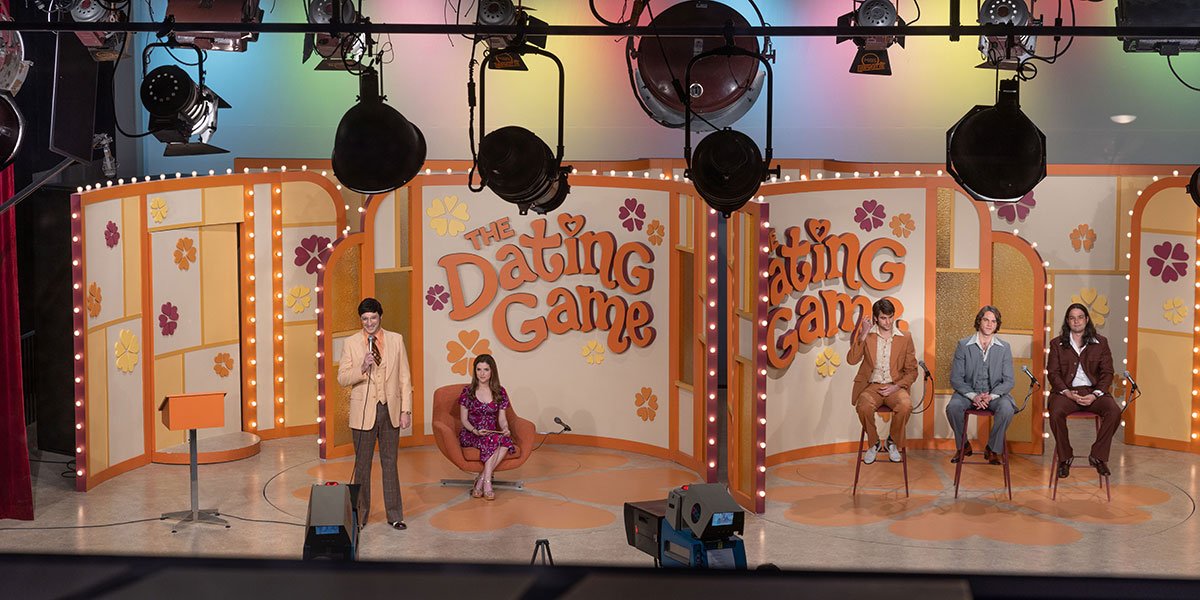‘Woman Of The Hour’ Review: Remember When A Serial Killer Went On The Dating Game? [TIFF]
(L-R) Tony Hale, Anna Kendrick, Matt Visser, Tighe Gill, & Daniel Zavatto in Woman of the Hour. Courtesy of TIFF.
With what is essentially a less dark, significantly shorter spin on David Fincher’s Zodiac, Anna Kendrick steps behind the camera and remains in front of it for her directorial debut, Woman of the Hour. The film tells a few small stories, all tied together through Rodney Alcala (Daniel Zovatto), a serial killer in the 1970s who, in the middle of his killing spree, went on The Dating Game on national television. We open in the past — a past based on the film’s relevant present of 1977 — as Rodney, posing as a professional photographer, takes photos of a young woman who thinks this opportunity is her big break. All seems to be going well until he latches his hand around her throat, strangling her, killing her on the spot.
Thus begins the first segment of one of our two narrative threads, as we jump around in time to Alcala’s various murders, all building in intensity that works toward a careful crescendo as all of the plot threads come together. The other main part of the story follows Cheryl Bradshaw (Kendrick), an aspiring actress who, after moving to LA, hasn’t landed any work (it can’t help that the casting directors are obscenely sexist). So, when her agent gets her a spot on The Dating Game, she takes it. And lo and behold, Contestant #3 is — wanna guess? — Rodney, the serial killer (just an overall shitty, manipulative person) whose story we ready ourselves to learn more about.
The biggest comparison one can make with Woman of the Hour is likening it to Fincher’s 2007 masterpiece Zodiac. These similarities mainly come from the narrative structural decision of cutting between a plot solely about the killer and one about another person (for Zodiac, the newspaper teams, for Woman of the Hour, Kendrick’s Dating Game contestant). While Zodiac tells its story in a more linear fashion, Woman frequently jumps around to different places in time, going from 1978 to ‘71, then back to ‘77. While not perfect, this storytelling is surprisingly effective, allowing tension to build during the second act to a brilliant crescendo in the third — similar to the infamous basement scene in Fincher’s film.
(L-R) Tony Hale, Anna Kendrick, & Daniel Zavatto in Woman of the Hour. Courtesy of TIFF.
The one fatal flaw in the storytelling, however, is the film’s ending. It’s presented with multiple opportunities to cut to black and maintain the effectiveness of its storytelling, but it instead opts for an extended epilogue (technically a prologue?) that takes away a lot of the impact of the film’s actual finale. Sure, it then adds in white text over a black screen — a staple of the “Based on true events” subgenre — but it does it in a way that works given the context of the story.
Anna Kendrick, marking her directorial debut, is a confident director, unafraid to use unconventional approaches to scenes ranging from people talking to people being murdered that creates an engaging visual language that feels distinct to the film and its approach to discussing these topics while maintaining a lighter tone — adding extra impact to the few scenes in which it leans darker. It’s this complete tonal control that makes the epilogue feel so strange, coming off as a first-draft thought rather than one that’s been thought of and reconstructed.
Kendrick is also strong as an on-camera presence, bringing her signature charm and energy to a film that demands a more restrained, dramatic performance while not feeling out of place. There’s a moment while Cheryl is on The Dating Game — you’ll know it when you see it — that displays Kendrick at the height of her power, giving her full control over her audience. Opposite her, Daniel Zovatto is also pretty great as a serial killer — if “great” is a reasonable descriptor. The energy he gives off, coupled with the great costumes and hairstyling, is instantly off-putting — you’ll dislike him from the moment he steps on screen.
Out of all the actor-turned-director efforts at TIFF thus far — though I haven’t seen them all — none have reached the height of Kendrick’s. If any of them have a shot at a real career in directing, it’s her.


